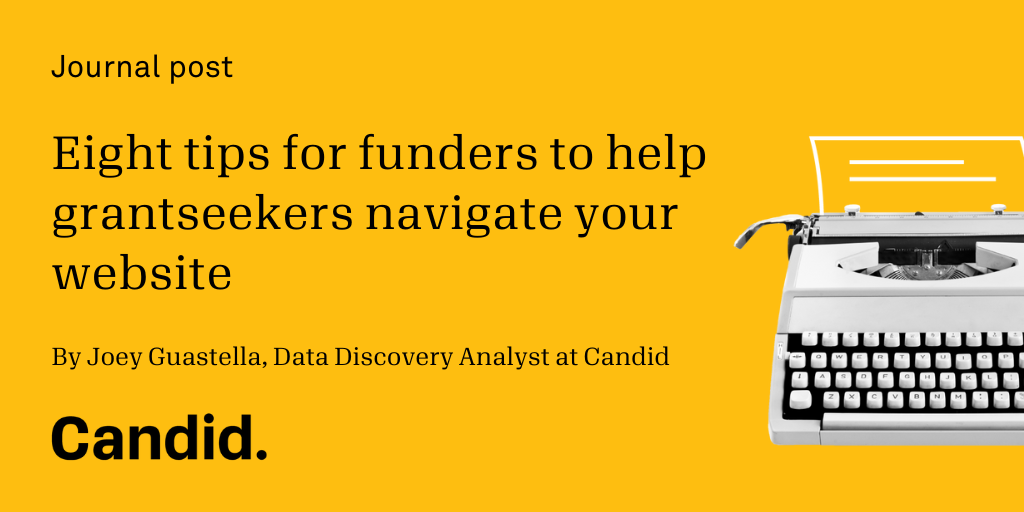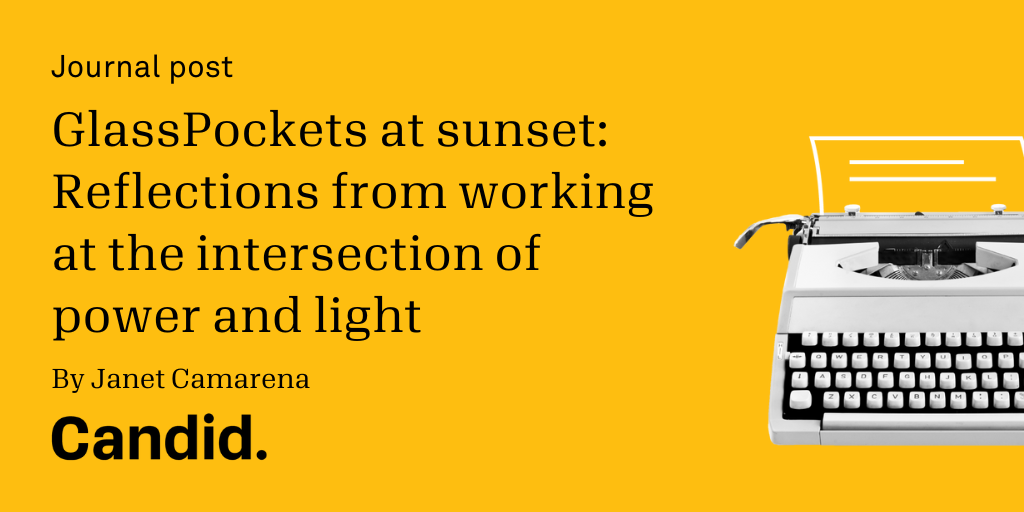Preparing for the Future of Philanthropy by Learning from its Past: Foundation Archives as a Vehicle for Transparency, Accountability, and Knowledge Transfer
(Emily Keller is an editorial associate in the Corporate Philanthropy department at the Foundation Center.)
In recent years there has been much written about the future of philanthropy. But what about its past and what we, as a field, can collectively learn from it? On December 11, Philanthropy New York sponsored a program exploring these themes. The program, "How Will Your Foundation's Story Be Told in 100 Years: Why Archives Matter," featured insights from archivists and foundation leaders about the significance and logistical issues of creating and maintaining archive records that are timely and accessible to internal staff and the public at large.
-- James Allen Smith
Established archives promote transparency by allowing the public to see inside foundations over the long term and contribute to the historical record of social and political movements, yet only a small portion of foundations have them. The discussion topics included access policies and the importance of functional data systems - both of which are needed to ensure the transparency of foundation information.
Benefits of Foundation Archives
John Craig, executive vice president and chief operating officer of The Commonwealth Fund, identified the benefits of archives as "an aid to understanding the past to wisely shape the future," as well as public accountability, providing institutional memory to new chief executives, program officers, and other foundation staff, enabling internal and external evaluations of a foundation's work, promoting institutional development and pride, exhibiting good management that extends to other responsibilities, and refuting accusations. "The sector does come under attack periodically and if you don't have archives to let people see what you did, you're often not positioned to defend yourself," Craig said.
Foundation Archive Survey Findings
Despite those benefits, a survey conducted during the fall of 2012 for the Commonwealth Fund revealed that only about 20 percent of large foundations (those with endowments of $240 million or more) maintain archives. The findings are detailed in a study that Craig initiated as a follow-up to a 1988 survey by his late colleague Kenneth Rose at Rockefeller Archive Center (RAC). Of large foundations with archives, 11 percent provide unrestricted access to all documents, 20 percent provide open access to most records with restrictions on sensitive materials, 47 percent provide access on a case-by-case basis, and 22 percent keep their archives closed. Craig describes the survey results in the report, The Archives of U.S. Foundations: An Endangered Species, which was published Dec. 20th as part of the Fund's 2012 annual report.
Access Policies
"At The Commonwealth Fund, we believe in as open access as possible," said Craig. All program files, grants, publications, and website contents are available as soon as they are processed, and governance and administrative documents and investment committee meeting minutes are available after ten years at RAC, which is located in Sleepy Hollow, New York, and also houses the archives of the Rockefeller Foundation, Rockefeller Brothers Fund, Ford Foundation, and others. Appointments to conduct archival research are required at RAC. The Fund, like most foundations, does not include rejected proposals, human resources documents, or detailed financial statements such as monthly reports in their archives, although annual financial reports are available as soon as they are published, Craig said.
Nicolette Lodico, director of information management at the Ford Foundation, said the foundation transferred its entire inventory of open archival materials - which document the history of the Foundation's work from 1936 to present - to RAC beginning in April 2012. Ford's longstanding policies for its archival collections call for the "freest possible access to and use of Foundation information, without infringing on the rights of the persons who created that information or hampering the current work of the Foundation." In transferring its collections to RAC, the foundation enjoys the highest quality organization and preservation of its collections, and is assured of open, efficient access of its archival materials to researchers from across the world. At the same time, researchers enjoy access to the foundation's collections within a larger archive that houses the collections of many other key philanthropic organizations. Foundation staff members frequently refer to archival collections to reflect on and tell stories regarding the foundation's work. For example, the archives were consulted frequently in preparing for the foundation's 75th anniversary events in 2011, as well as in preparing to mark its 50 years of grantmaking in Latin America in 2012.
Jane Gorjevsky, digital assets archivist at Columbia University, where the Carnegie Corporation of New York has kept its archives since 1990, said that archives improve the accuracy of a foundation's stories, as told by themselves and others, and increase awareness of their role and social impact. "They also save the foundation's staff significant time and effort, since staff members have easy access to historical data that can be utilized for outreach, reports, and decision-making," Gorjevsky said.
The Corporation provides access to board and executive committee files, publications, and other documents at the Rare Book and Manuscript Library of Columbia University, where visitors can view staff and trustee files after 15 years, legal files after 20 years, and inactive grant files after 10 years. Gorjevsky said the Corporation is considering an extension to the waiting period for digital grant files to offer additional protections to grantees in response to the growing frequency of electronic information sharing, but restrictions may be lifted for a bona fide research purpose. Those files include preliminary correspondence, suggestions and critique, grant applications, interim reports, extension requests, and external evaluations, and may contain confidential information like bank account numbers, Gorjevsky said.
"The Corporation is concerned that the electronic materials' ease of distribution (combined with their ever-growing volume that makes it impossible to inspect each individual document) might pose a problem for the grantees' intellectual property rights and their privacy," Gorjevsky said. "In the pre-Internet paradigm, a researcher could view these documents in the archive (ten years after the grant has been closed) and make photocopies, but did not have an option for making documents instantly publicly accessible for the entire world."
From Archives to Accountability
James Allen Smith, vice president and director of research and education at RAC, emphasized the significance of accessible archives in capturing the historical impact of philanthropy and promoting accountability in the sector. "As more foundation archives are opened, we can begin to tell stories not just of single foundations and their individual projects but of the ways in which foundations have worked together. We can tell the stories of foundation efforts in entire fields such as agriculture, social welfare, and public health," Smith said.
"Providing access to foundation records is an important part of a foundation's public mission. Foundation archives tell us how organizations are working to provide public benefits, why they succeed or fail. Archives, I would argue, are an even more important part of our framework of accountability than 990-PFs and annual reports. Archives are where we can begin to have long-term and independent assessments of the work of the philanthropic sector," Smith said.
Logistics of Creating and Maintaining Archive Systems
Foundation archives with open access policies go a long way toward ensuring the transparency of philanthropic data, but making those systems effective requires a detailed organization and maintenance plan. Experts advise foundations that are opening their archives to the public to focus on records with permanent historical value rather than including everything; examine the benefits of outsourcing the project versus keeping it in-house; avoid backlogs in data processing, which are often several years long; and develop a plan for holding digital data created with various hardware and software programs that may be on the verge of obsolescence.
Craig said the digital revolution poses big challenges to archivists, given uncertainties about the permanence of digital records and rapid changes in technology, but that it should ultimately improve the capacity to archive records in a timely way and facilitate access to them. Thus, he suggests, the digital revolution should spur more foundations to maintain archives.
How do you think an increase in foundation archives would benefit the sector and society at large? What data would you like to see in their collections? How should foundations design their access policies to maximize transparency while protecting grantee and foundation privacy? Please share your thoughts below.
Foundation Archive Resource List
- Directory of Archival Consultants by the Society of American Archivists, a professional association that serves more than 5,500 individual and institutional members.
- Foundation archives: information, access, and research by the Council on Foundations. Includes Kenneth W. Rose's "The State of Foundation Archives: Results from the Rockefeller Archive Center's Survey of the Thousand Largest American Foundations."
- The availability of foundation records: a guide for researchers by Kenneth W. Rose, with additional information on the 1988 study.
- Some reasons to rethink foundation records management policies by Peter Dobkin Hall, published by Philanthropy Monthly.
- How long should nonprofit organizations retain business-related records? Information on document retention policies in the Sarbanes-Oxley Act of 2002, posted on GrantSpace.
- Thoughts on Establishing Foundation Archives by Richard J. Kaplan, published by the Council on Foundations.
--Emily Keller



